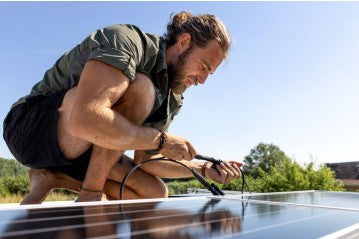
As the demand for renewable energy sources grows, solar power has emerged as a popular choice for individuals seeking sustainable and cost-effective solutions. A crucial component of any solar energy system is the inverter, which converts DC (direct current) electricity generated by solar panels into AC (alternating current) electricity suitable for powering household appliances. In this article, we will explore the various applications of a 3000-watt inverter, considerations for battery selection, cable sizing, and how to effectively use this powerful device.
1. The five most popular use cases for a 3000-watt inverter
A 3000-watt inverter offers a substantial power output, enabling it to handle a range of appliances and devices. Here are five common use cases for this capacity:
a) Residential Use: A 3000-watt inverter can power multiple essential appliances simultaneously, such as refrigerators, televisions, laptops, and small kitchen appliances. It is suitable for providing electricity in off-grid or emergency situations.
b) RV and Camping: With the popularity of recreational vehicles and camping, a 3000-watt inverter is an ideal choice for those who want to enjoy the comforts of home on the road. It can power air conditioning units, microwaves, coffee makers, and other small appliances commonly found in RVs.
c) Construction Sites: In remote construction sites or areas lacking traditional power sources, a 3000-watt inverter becomes indispensable. It can power heavy-duty tools and equipment like electric saws, drills, and compressors, enhancing productivity and convenience.
d) Mobile Food Businesses: Food trucks and mobile catering businesses require a reliable power source to run cooking equipment, refrigerators, and cash registers. A 3000-watt inverter can accommodate these power-hungry appliances, ensuring seamless operations.
e) Small-scale Business: Home offices or small-scale businesses often need a backup power solution to keep essential equipment running during power outages. A 3000-watt inverter can support computers, printers, communication devices, and lighting, helping maintain productivity and avoid downtime.
2. How Many Batteries Do I Need to Power a 3000w Inverter?
The number of batteries required to power a 3000-watt inverter depends on various factors, including the battery capacity and desired runtime. To estimate the number of batteries, consider the following:
a) Battery Capacity: Determine the ampere-hour (Ah) rating of your batteries. For example, if you have 200Ah batteries, each battery can store 200 ampere-hours of energy.
b) Inverter Efficiency: Inverter efficiency affects the power consumption and battery runtime. Assume an efficiency of 85% (0.85) to account for power losses during the conversion process.
c) Load Calculation: Calculate the total load or power consumption of the appliances you intend to connect to the inverter. Add up their power ratings in watts to determine the total load in watts.
d) Battery Calculation: Divide the total load in watts by the inverter voltage (usually 12V or 24V) to find the current in amperes. Then divide this value by the battery voltage (12V or 24V) to obtain the current drawn from each battery. Finally, divide the current drawn from each battery by the battery capacity (Ah) to determine the number of batteries needed.
Remember to consider safety margins and avoid deep discharges that can shorten battery life. Consult the manufacturer's specifications and seek professional advice to ensure accurate battery sizing.
3. What Size Cable Do I Need for a 3000-Watt Inverter?
Choosing the appropriate cable size is crucial for minimizing power losses and ensuring efficient energy transmission. Consider the following guidelines:
a) Current Capacity: Determine the maximum current capacity required by your inverter. Divide the power output (3000 watts) by the inverter voltage (12V or 24V) to calculate the maximum current.
b) Cable Sizing: Consult a wire sizing chart or an electrician to determine the appropriate cable gauge for your specific current capacity. Using undersized cables can result in voltage drops, increased resistance, and potential overheating.
c) Length Considerations: Longer cable lengths increase resistance and voltage drops. If you anticipate longer cable runs, select a slightly thicker cable gauge to compensate for this loss.
d) Material and Insulation: Opt for high-quality cables made from copper, as they offer lower resistance and superior conductivity. Additionally, ensure the cables have suitable insulation to protect against environmental factors and prevent short circuits.
Always prioritize safety and adhere to local electrical codes when installing cables for your inverter system. Professional guidance can be invaluable for cable sizing and installation.
4. How Do You Use a 3000-Watt Inverter?
To make the most of your 3000-watt inverter, follow these steps for effective usage:
a) Installation: Position the inverter in a well-ventilated area away from direct sunlight, moisture, and flammable materials. Connect the inverter to the battery bank using appropriately sized cables, ensuring tight and secure connections.
b) Load Connection: Determine the appliances or devices you wish to power with the inverter. Connect them using suitable AC outlets or through a distribution panel. Take into account the power ratings of each device and the total load capacity of the inverter.
c) Power Management: Prioritize essential appliances and distribute power usage to avoid overloading the inverter. Consider using power-saving features on devices and switch off non-essential equipment when not in use.
d) Monitoring and Maintenance: Regularly monitor the inverter's performance, voltage levels, and battery health to ensure optimal operation. Clean and inspect connections periodically, and follow manufacturer guidelines for maintenance and troubleshooting.
Conclusion
A 3000-watt inverter unlocks a world of possibilities for harnessing solar power. From residential applications to mobile businesses, construction sites to recreational activities, this powerful device empowers individuals to embrace renewable energy and reduce their carbon footprint. By understanding the diverse use cases, battery requirements, cable sizing considerations, and effective usage guidelines, customers can confidently integrate a 3000-watt inverter into their solar energy systems, providing a reliable and sustainable power source for their needs.
ECGSOLAX offers high quality 3000w inverters. If you are interested in our products, please contact us and learn more:
3000W DC 24V AC 220V All-In-One MPPT Solar Inverter Charger
3000W DC 24V AC 220V Hybrid Pure Sine Wave MPPT Inverter Charger

0 Kommentare